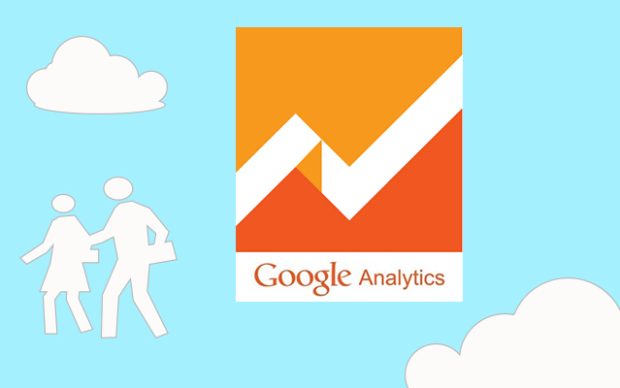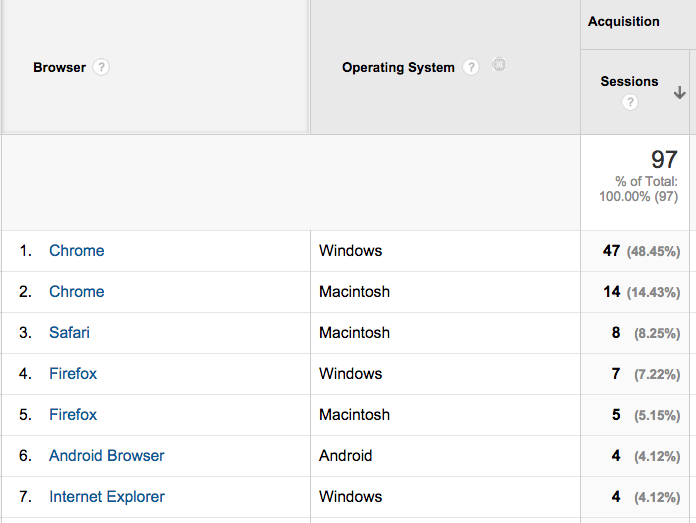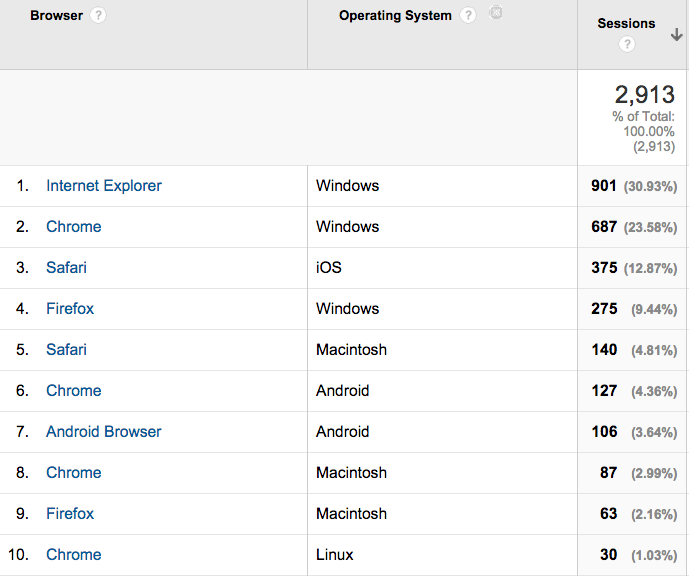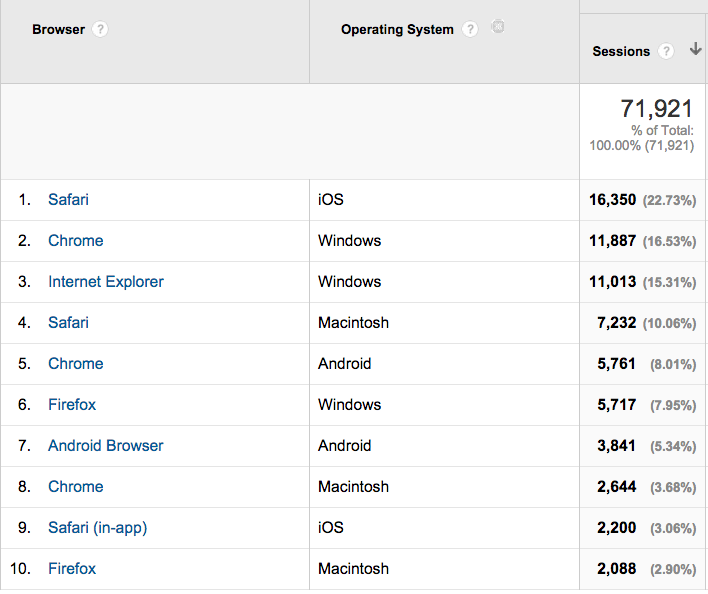
Your user demographics are more than just a cloud abstraction.
I'm going to open up and share a secret with you: You can get a rounded-out demographics picture of who is looking at your website from the Browser and Operating System reported in Analytics.
This came to my attention while vetting a client site for usage of IE7 (should we REALLY scale back to IE7?) While Analytics likes to think it knows things like gender, age, race demographics (and probably what you ate for breakfast,) the only hard-line data it can really measure about you is your browser and operating system which get sent with every request for every click and web page. While Analytics prides itself on being able to draw information about you through your browsing, these conclusions about you are abstract; and therefore somewhat unreliable. Your browser and operating system talk about you and the population sharing your browsing hardware and software preferences in a way that is more valuable because the evidence is absolute.
So what does browser use say about a user?
Generally, the use of an alternative browser like Chrome, Firefox, or Opera on any operating system means that a person or someone close to them has elected a browsing experience that they feel is improved from the default one that ships with their computer (whether it is or not.) There are handfuls of reasons for this - be they special browser add-ons or as a developer, an improved debugging system. Perhaps they need to run multiple browsers at a time. Perhaps they dont trust The Man who made their computer. No worries, it doesnt matter. These folks are separate from the Safari and Internet Explorer users of the world (and comparative Android browser users on Android devices) who have not elected a browsing experience on their computer/device and just go with it. Hey, if it connects, it works! right? There is also a small number of people in this group who are unable to download new software due to install locks on their machines and these folks on lockdown are generally at work (or in some kind of state/govt non-work environment.) These machines generally dont get updated and these browsers and operating systems have a pattern of being antiquated as well as standard to their (old) system. And they tend to be on Windows IE 6 or 7. (Never try to scale back to IE6.)
The following is a screenshot of my own Analytics, taken from the Overview -> Technology section, under Browser & OS. I added the Operating system as a secondary Dimension, in the drop down under Users.
Aside from needing an overall traffic boost, you can see that my sleepy little site has quite a few hits from Macintosh systems, and alternative web-savvy users on Windows using Chrome:

As you can see, the largest constituency using a default browser for their system, Safari for Macintosh, is only 8 users out of 97 for the month, or around 8%. The next is Android Browser for Android and Windows Internet Explorer, each around 4%. All the rest of the sites users represented in the grid have chosen their own browsers for their system. This tells me that they probably comprise of
- My colleagues - who have specific Operating system preferences and almost never browse on the default browser. Hi, friends!
- Potential clients (Android browser, high count of Windows Chrome) browsing on behalf of corporations shopping Petroglyph for possible website work.
- Potential agency clients (high count of mac Users) and my mom, of course.
Lets have some fun with some other site analytics:

Tons of Windows and iPhone/iPad! This says Im at work or at the library all over it. The overwhelming mobile constituency (over 20% just in this view) and much of that on default browsers suggests that the site may be used as a resource for researchers (student or professional) or for leisure time. Additionally, it should absolutely be mobile-friendly as its mobile count soars to double the 10% [arbitrary] user count deemed significant mobile usage by the industry. The significant use of alternate browsers (especially Chrome/Windows) underscores that the user base may be disproportionally educated.
Heres a fun one:

Holy iPhone, Batman!! And Android! And Windows! Almost in that order (one can dream.) This site is clearly being used during spare time, potentially on commutes or even on mobile at work to get around blocks on a work network - though clearly it isnt being blocked by every work network. This one has an obvious need to be mobile friendly - but more than that, completely responsive, as its user base appears to be as keen to access the site from the mobile device as they are from the computer (at almost 40% mobile usage!)
The examples provided are just models that I happen to be able to share, but being so different, they really do illustrate that depending on the site and its usage, it can be either incredibly important or not at all to drill down to obscure/difficult populations of IE7 users or to Android browsers. Another post entirely: doing a little math, I could compare the above values to the W3Schools Browser Statistics and really measure what user bases included here are higher than normal and which ones are normal, based on every persons browser usage on the whole net. Sounds useful right?
And as for that site I was looking to determine if we needed to get to IE7 users - they were at approximately 4,500 - so yes, that was absolutely necessary!